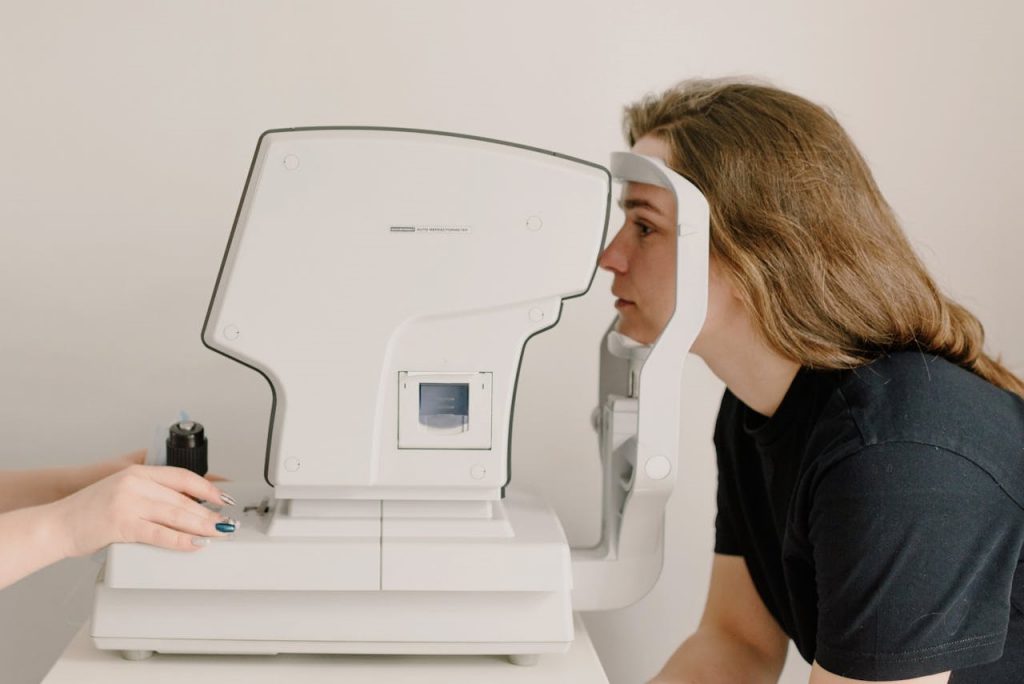 Being sick in a foreign country can be a frightening experience. That is why our article about the body, health and medical emphasises why understanding basic medical vocabulary in English is crucial to navigating healthcare anywhere in the world. Whether you say, ‘Something is stuck in my throat’ or ‘I have a pain here …’ and point to your neck, using precise terms allows your doctor to provide the best help possible.
Being sick in a foreign country can be a frightening experience. That is why our article about the body, health and medical emphasises why understanding basic medical vocabulary in English is crucial to navigating healthcare anywhere in the world. Whether you say, ‘Something is stuck in my throat’ or ‘I have a pain here …’ and point to your neck, using precise terms allows your doctor to provide the best help possible.
This is especially important in eye care, as problems with vision can affect daily life and general quality of life. By being well-prepared with the right vocabulary, you thus help your eye specialist preserve your vision. Below, we explore using English when checking your eye health.
Identifying common eye diseases
Eye disorders can significantly affect vision, often involving the retina, iris, lens, cornea, or optic nerve. A 2021 review in Medical News Today explains that various conditions can lead to vision problems or even blindness if left untreated.
Here are some common eye problems that you may encounter during an eye check-up and explanations of what each phrase means:
- Myopia (Short-sightedness): Myopia causes distant objects to appear blurry while close objects can be seen clearly.
- Hyperopia (Farsightedness): Hyperopia makes close objects look blurry, while distant objects are clearer.
- Astigmatism: An irregular shape of the cornea or lens causes distorted or blurred vision at all distances due to improper light focusing.
- Presbyopia: This age-related condition reduces the eye’s ability to focus on nearby objects, making reading and other close-up work difficult.
- Cataract: A cataract causes the lens of the eye to become cloudy, leading to blurry vision and glare. It commonly develops with age.
- Glaucoma: This group of diseases damages the optic nerve, often due to high intraocular pressure, leading to progressive vision loss and potentially blindness.
- Age-related Macular Degeneration (AMD): AMD affects the macula, the central part of the retina, causing loss of central vision. It can be wet or dry, and treatment approaches vary.
Booking an eye exam
Whether you have an eye disorder or not, it is crucial to have an eye test every two years. Thanks to the range of online vision retailers, it’s easier than ever to set up an eye exam appointment online, even as a non-native speaker.
If you aren’t confident about using an English website, you can try using browser extensions or Google Translate to translate the required details. Otherwise, you can call your nearest optician and ask, “Can I book an eye exam?” Your optician may then present various options.
Most opticians in the UK offer the government-funded NHS Eye Test alongside their private services. Popular company Vision Express offers an Advanced and Standard Eye Test at their 550 stores nationwide.
This test typically includes an eye health screening to check for conditions such as dry eye and glaucoma, a vision test to assess how well you see, and a personal recommendation where treatments are discussed.
It’s helpful to let the optician know that you are learning English as a ESL speaker, so they can assist you more effectively in every step. You might say something like, “I am an ESL speaker, so please speak slowly and feel free to repeat anything if needed.”
Describing your symptoms
The eye health screening is an opportunity to discuss all your symptoms in detail. Start by mentioning any common eye symptoms you have, such as blurred or cloudy vision, sore or tired eyes, or difficulty focusing.
You should also provide a comprehensive picture of your daily life. Registered optometrist Neema Ghorbani-Mojarrad from the University of Bradford explained that conditions like myopia rarely stem from genetics alone. Describe how much time you spend on screens, your outdoor activities, and any family history of eye conditions. This information helps the optician understand potential contributing factors to your vision problems and tailor their recommendations to your specific needs.
Understanding your prescription
A common issue when checking your eye health is misunderstanding treatment instructions. This happens frequently with glaucoma cases, where patients have difficulty keeping their eyes or hands steady when applying eye drops, causing doctors to later prescribe eye drop aids like Autodrop. You must communicate your treatment concerns with your doctor in advance, and a simple “I’m not sure” or “Can you teach me?” goes a long way in finding solutions.
Having your doctor write down and illustrate the prescription details can also help you double-check instructions in your local language later. This can also assist you in finding the necessary supplies at the pharmacy if the doctor’s office does not provide them.
By using the right vocabulary and knowing what to expect, you can ensure a more successful and informative eye care experience. For more on learning English and using English in your day-to-day activities check out our other resources in our English Essentials section and throughout the site.
